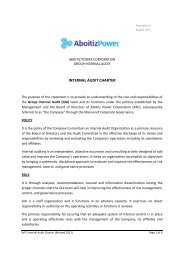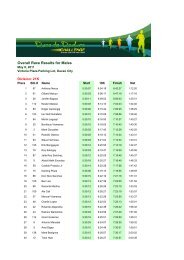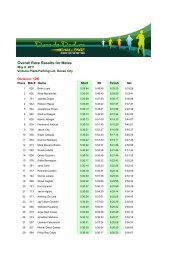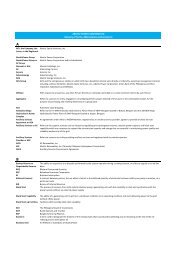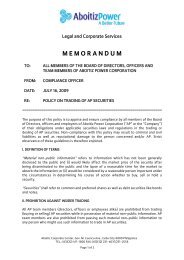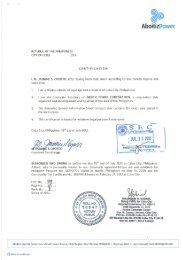enabling sustainability - Aboitiz Power
enabling sustainability - Aboitiz Power
enabling sustainability - Aboitiz Power
Create successful ePaper yourself
Turn your PDF publications into a flip-book with our unique Google optimized e-Paper software.
GRI G3 Level C Disclosures<br />
1.1.<br />
STRATEGY AND ANALYSIS<br />
Statement from the most senior decision maker of the<br />
organization about the relevance of <strong>sustainability</strong> to the<br />
organization and its strategy<br />
ORGANIZATIONAL PROFILE<br />
2.1. Name of organization<br />
2.2. Primary brands, products and / or services<br />
2.3. Operational structure of the organization, including main<br />
divisions, operating companies, subsidiaries and joint ventures<br />
2.4. Location of organization’s headquarters<br />
2.5. Number of countries the organization operates<br />
2.6. Nature of ownership and legal forms<br />
2.7. Market served (including geographic breakdown, sectors served<br />
and types of customers / beneficiaries)<br />
2.8. Scale of the reporting organization, including:<br />
Number of employees<br />
2.9. Significant changes during the reporting period<br />
2.10. Awards and recognitions received during the reporting period<br />
4.1.<br />
4.2.<br />
4.3.<br />
4.4.<br />
EC1<br />
EC2<br />
GOVERNANCE<br />
Governance structures of the organization, including committees under<br />
the highest governnace body responsible for the specific tasks, such as<br />
setting strategy or organizational oversight<br />
Indicate whether the Chair of the highest governance body is also an<br />
executive officer (and, if so, their function within the organization’s<br />
management and the reasons for this arrangement)<br />
Number of independent and non-executive members<br />
Mechanisms for shareholders and employees to provide recommendations<br />
or direction to the highest governance body<br />
4.14. List of stakeholders groups<br />
4.15. Basis for identification and selection of stakeholders groups<br />
ECONOMIC PERFORMANCE<br />
INDICATORS<br />
Direct economic value generated<br />
Financial implications and other risks and opportunities for the<br />
organization’s activities due to climate change<br />
3.1.<br />
3.2.<br />
3.3.<br />
3.4.<br />
3.5.<br />
3.6.<br />
3.7.<br />
3.8.<br />
3.11.<br />
3.12.<br />
REPORT PARAMETERS<br />
Reporting period (fiscal / calendar year) for information provided<br />
Date of most recent previous report (if any)<br />
Reporting cycle (annual, biennial, etc)<br />
Contact point for question regarding the report and its contents<br />
Process of defining report content, including:<br />
Determining materiality<br />
Prioritizing topics within the report,<br />
Identifying stakeholders the organization expects to use the report<br />
Boundary of the report (subsidiaries, joint ventures, etc)<br />
Limitations on the scope and boundary of the report<br />
Basis for reporting on joint ventures and subsidiaries<br />
3.10. Explanation of the effect of any re-statements of<br />
information provided in earlier reports, and the reasons for<br />
such re-statement<br />
Significant changes from previous reporting period<br />
Table identifying standard disclosures of report<br />
EN5<br />
EN6<br />
EN7<br />
EN13<br />
EN14<br />
EN16<br />
EN18<br />
EN26<br />
ENVIRONMENTAL PERFORMANCE<br />
INDICATORS<br />
Energy saved due to conservation and efficiency improvements<br />
Initiatives to provide energy efficient or renewable energy based products<br />
and services, and reduction in energy requirements as a result of these<br />
initiatives<br />
Initiatives to reduce indirect energy consumption and reductions achieved<br />
Habitats protected or restored<br />
Strategies, current actions, and future plans for managing impacts on<br />
biodiversity<br />
Total direct and indirect greenhouse gas emissions by weight<br />
Initiatives to reduce greenhouse gas emissions and reductions achieved.<br />
Initiatives to mitigate environmental impacts of products and services,<br />
and extent of impact mitigation<br />
Economic Performance<br />
Labor practices<br />
Reports intended to<br />
qualify for level C,<br />
C+, B, B+, A or A+<br />
must contain each<br />
of the criteria that<br />
are presented in<br />
the column for the<br />
relevant level.<br />
APPLICATION LEVEL CRITERIA<br />
Report<br />
Application Level<br />
G3 Profile<br />
Disclosures<br />
G3 Management<br />
Approach<br />
Disclosures<br />
G3 Performance<br />
Indicators &<br />
Sector Supplement<br />
Performance Indicators<br />
STANDARD DISCLOSURES<br />
OUTPUT<br />
Report on:<br />
1.1<br />
2.1 - 2.10<br />
3.1 - 3.8, 3.10-3.12<br />
4.1 - 4.4, 4.14 - 4.15<br />
LA1<br />
LA3<br />
LA11<br />
SO1<br />
RECHARGE COMMUNITIES<br />
INDICATORS<br />
Total workforce by employment type, employment contract<br />
Average hours of training per year per employee by employee category<br />
Benefits provided to full-time employees that are not provided to<br />
temporary or part-time employees, by major operations<br />
Programs for skills management and lifelong learning that support the<br />
continued employability of employees<br />
Nature, scope and effectiveness of any programs and practices that<br />
assess and manage impacts on communities<br />
C C+ B B+<br />
A A+<br />
Not Required<br />
Report on a minimum of<br />
10 Performance Indicators,<br />
Including at least one from<br />
each of:<br />
• social<br />
• economic<br />
• environment<br />
REPORT EXTERNALLY ASSURED<br />
Report on all criteria listed<br />
for level C +<br />
1.2<br />
3.9, 3.13<br />
4.5 - 4.13, 4.16 - 4.17<br />
Management Approach<br />
Disclosures for each<br />
Indicators Category<br />
Report on a minimum of<br />
20 Performance Indicators,<br />
Including at least one<br />
from each of: economic,<br />
environment, human rights,<br />
labor, society, product and<br />
responsibility<br />
REPORT EXTERNALLY ASSURED<br />
Same as requirement for<br />
Level B<br />
Management Approach<br />
disclosed for each<br />
Indicator Category<br />
Respond on each core G3<br />
and Sector Supplement*<br />
indicator with due regard<br />
to the materiality Principle<br />
by either:<br />
• reporting on the indicator<br />
• explaining the reason for<br />
its ommission<br />
REPORT EXTERNALLY ASSURED<br />
ABOITIZ SUSTAINABILITY REPORT 2010<br />
3



